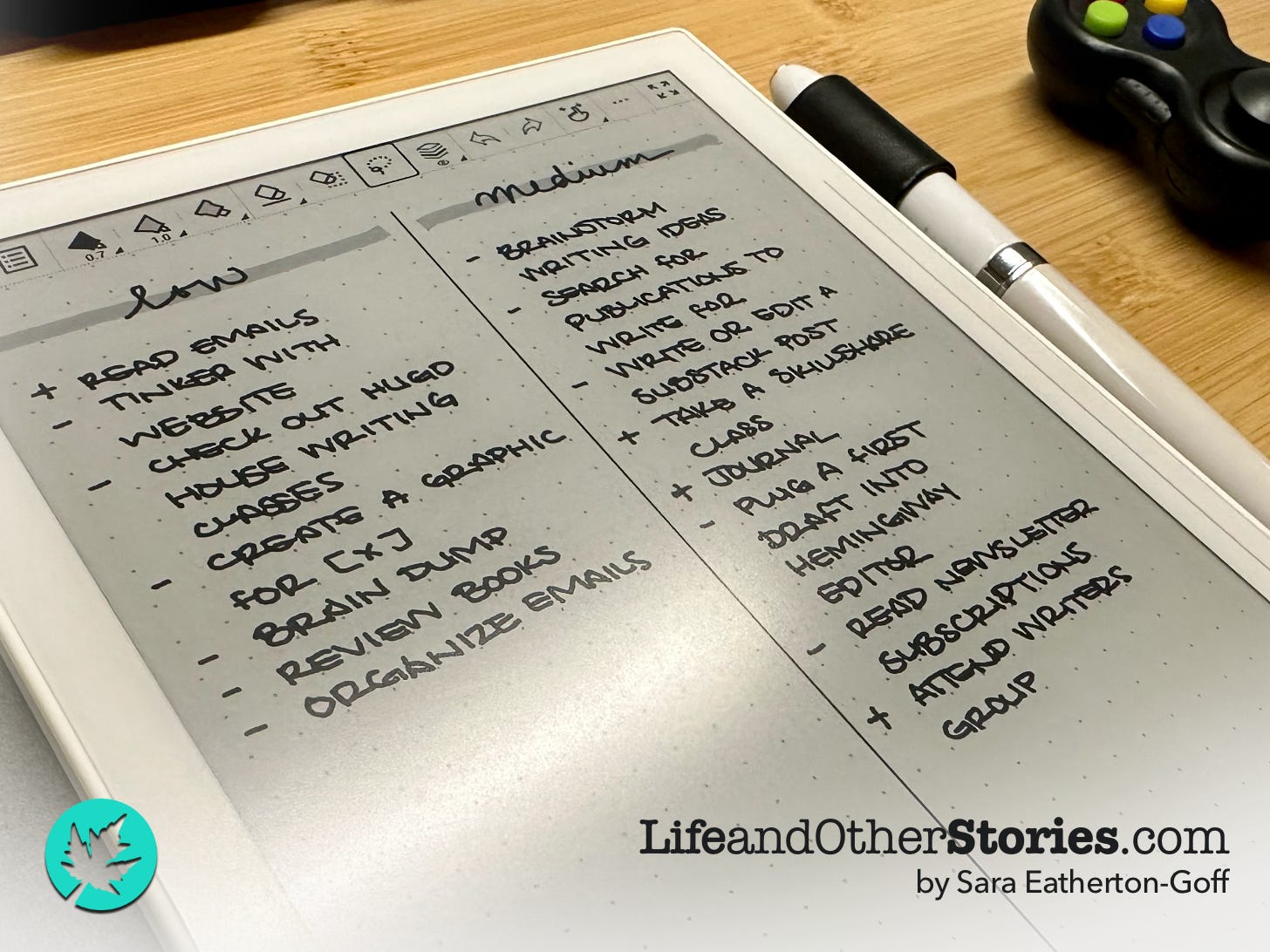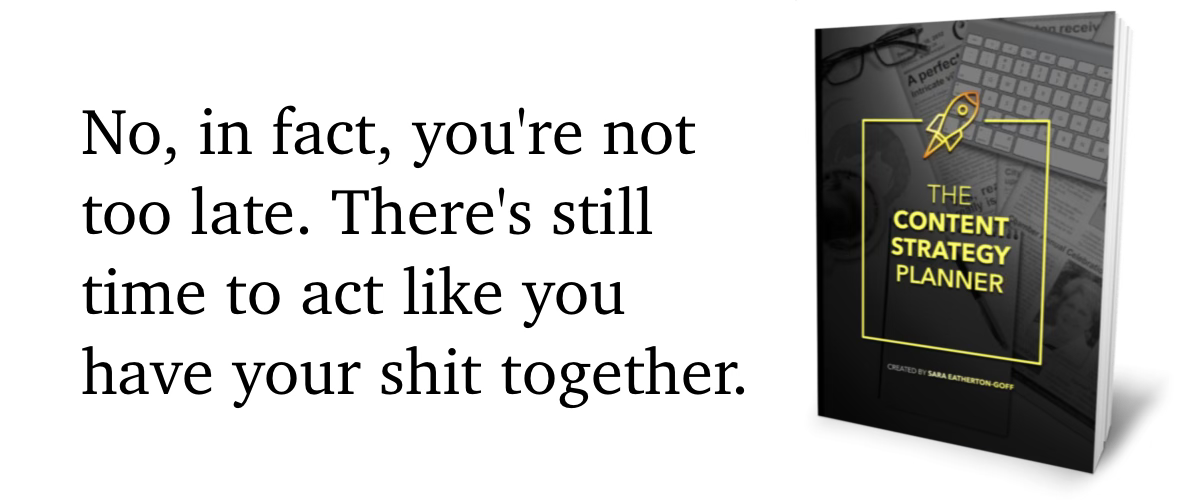Energy-Level Thinking & Planning
Because forcing ourselves to work a high-energy task when we have low energy is ridiculous. There's a better way to complete the project. Here's how.
This newsletter has moved!
To receive new and infrequent musings, the latest fiction and non-fiction narratives, updates, and "life nuggets”, subscribe here.
Are you familiar with bullet journaling?
If not, Very Well Mind describes a bullet journal (also known as a “bujo”) as a mix of a daily planner, to-do list, and diary.
The bullet journal is an analog journaling system created by New York-based designer Ryder Carroll. He describes this planner / journaling approach as a method to "help you track the past, organize the present, and plan for the future.”1
Bullet journaling changed the way I plan and work. But one major, life-changing idea snagged from the bujo community was energy-level thinking and planning takes the cake for me, seeing that I was already designing my own planners and templates before bullet journaling hit the mainstream.
Roughly five years ago I came across an ADHD, minimalistic bullet journalist who helped reshape the way I thought about planning. (I wish I could remember her YouTube handle….)
After creating various planners in the past decade, I thought I had the whole “simpler is better” thing on lock. But when I stumbled onto bullet journaling, I was tempted by the gorgeous spreads others proudly presented on Instagram and, as I later discovered, on the r/bulletjournal subreddit.
But the more elaborate the spreads I created, the less actual effective planning and progress got done.
So when I noticed said bullet journalist’s simple approach, my effectual world opened up. Her layouts were beautiful, but unlike most of the intricately designed notebook shots I came across, hers had long rows of completed tasks.
Her most inspirational (to me) spread contained two columns splitting up two general energy levels: Low and High.
Her list regarded home cleaning/tidying tasks, but the basic concept can apply to many areas of life and work.
My first adaptation was for work (of course). Like with my goal setting approach, I wrote “Work Tasks” in the center of a piece of paper. Then brainstormed all the activities and tasks I already do or want/should do to boost professional progress.
Once I had a robust list, I assigned an L, M, or H next to the task—Low, Medium, and High.
From there, I created three organized columns in my digital bullet journal for the Low, Medium, and High -Energy Tasks.
Under High I had things like:
Write a short story
Work on a guest-writing piece
Market new or existing pieces
Under Medium I had:
Read
Brainstorm writing and project ideas
Work on a [Substack] post
Under Low I had things like:
Search for (publications) to write for
Journal or “brain dump”
Create a graphic for (X) or tinker with website (which could mean adding new content links as needed, research the latest trending homepage layouts, etc.)
Treat these lists as evergreen and productivity-enhancing.
They can serve as your continued momentum while keeping you in a healthy mental and, often, physical state.
(And now that I’m writing about this, I hope it finally motivates me to update my energy-level tasks lists for home upkeep, for home-cooked meals, and to even create one for family activities.)
How I Use My Energy-Level Lists
Before I sit down to work, I assess how I’m feeling and where my energy level is. (Yes, this is also a great practice for fellow Autists; especially those of us with alexithymia2.)
I then refer to my list for ideas on what activities to do. This way I’m always productive without stretching myself beyond what I can handle in that day or moment.
This doesn’t mean that I ditched theming work days or anything, but I adapted that method into a new way of working.
For example: Each energy-level list has at least one task to progress each area of work or of a project.
Let’s say I need to write a Substack post. My dedicated post-writing day (now) is Thursday. If I wake Thursday morning and note that my energy level is low, I'll brainstorm topic ideas, or plug a first draft or free-written piece I’m considering for next week’s post into the Hemingway Editor app (you can tinker with it here for free, and get it here—no affiliation, I just like it) and let it dissect the crap out of my writing.
(Note: The Hemingway App, I’d say, is specifically for online writing. It will ruin prose writing by oversimplifying your work.)
At a medium-energy state (my general state of being), I can write or edit a new post. On these days, I also rely on my husband or a writer- or reader-friend to read through a piece and give me feedback.
(My early drafts are seemingly always disjointed, and often went published that way in the past.… I need to put a lot of distance between myself and fresh writing, but when you do a weekly newsletter, that’s fairly impossible. So getting outside help, for me, is something I’ve recently discovered to be a necessary addition to my process.)
My husband’s been helping me connect my thoughts better. His engineer-brain helps me cut the fat out of my blubbery writing.
At a high-energy level, I’m writing, editing, and marketing new and previous pieces, etc.
Another example that may be more generally applicable is reading. I love reading, but especially since I had Covid, my ability to concentrate differs day-to-day. So on a low-energy day, now, I’ll review my hard-copy books. If there are any titles I don’t want anymore, they're added to a tote in my closet to review again when my energy level is higher. (Later those totes go to one of the various used book stores locally that purchase books, and whatever isn’t sold goes into one of those cute little free libraries sprinkled throughout the city.)
Another low-energy “reading” task is to review my email newsletter subscriptions to see if there’s anything I’m not interested in anymore. While in a low-energy state, I write down the newsletter title and what it covers, as well as the date I unsubscribed from it. (I often find myself re-subscribing later, though—hence why I jot down some details beforehand. My brain is fickle.…)
At a medium-energy level, I’ll read newsletters I’m subscribed to, or sometimes a book, if it’s not too complex.
At a high-energy level, I will dedicate at least an hour to reading if my brain is willing to comply; because right now, even if my energy is up, it doesn’t mean my ability to concentrate is.
I’m a very different person at each energy level, and I try to care for my state of wellbeing accordingly.
It’s like parenting: a one-size approach doesn’t fit all for each child.
Children don’t all respond to the same form of praise nor “punishment”. So, why would we try to force ourselves at a low-energy level to do something only our High-Energy Self could do?
I never know what state I’m going to be in day-to-day, and often portion-of-the-day-to-day basis. I may wake well-rested and excited for the day, but by the time I sit down for my coffee-breakfast, I’ve run myself down already (probably tidying the house before work, or simply just getting the kids out of the house and off to school).
Nothing’s ever certain. But I’m prepared in some way, shape, or form for each area of need to progress in my life and work.
And don’t forget to prioritize rest.
Something I have to remind myself often of is to rest. And these lists actually help a great deal.
If I'm having trouble deciding what low-energy task to do, often it's my body or brain trying to communicate that it's not able or willing to do anything.
This is said from a place of privilege, I know, but prioritizing rest is important for anyone who needs it.
How will you keep track of your lists?
Would you use a bullet journal with a sticky-note tab marking the page(s) for quick-reference? Do you keep your lists in the Notes app on your device(s)? Do you keep a saved audio file that dictates your list back to you, which you’ve pre-organized each file by energy level?
I keep my current, active list in my digital bullet journal, but have mostly committed them to memory at this point.
On low-energy days/moments—go figure—I always need to refer to that list though.
My initial list-keeping method was typed up in an Apple Pages document, in card templates on two pages (totaling four cards, front and back). Then I printed them front and back, cut them out, and laminated them.

I hope you found something valuable in today’s post.
Next, I’ll share about how I “preview plan” to set myself up for 6 months at a time.
Thanks for reading, liking, and maybe even commenting.
My best,
Sara
support my work and | “buy me a coffee” (a one-time tip)
offer ongoing support and | become a Patreon patron
get the | Content Strategy Planner
visit the website | segwrites.com
(Stress Management) What Is A Bullet Journal?, Very Well Mind.









